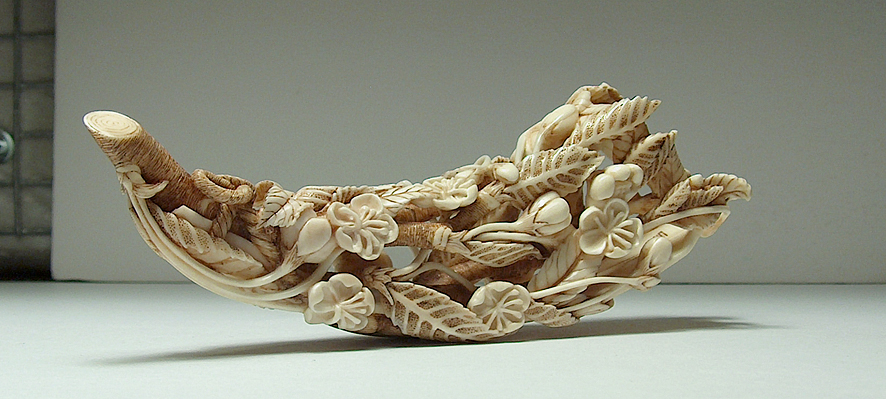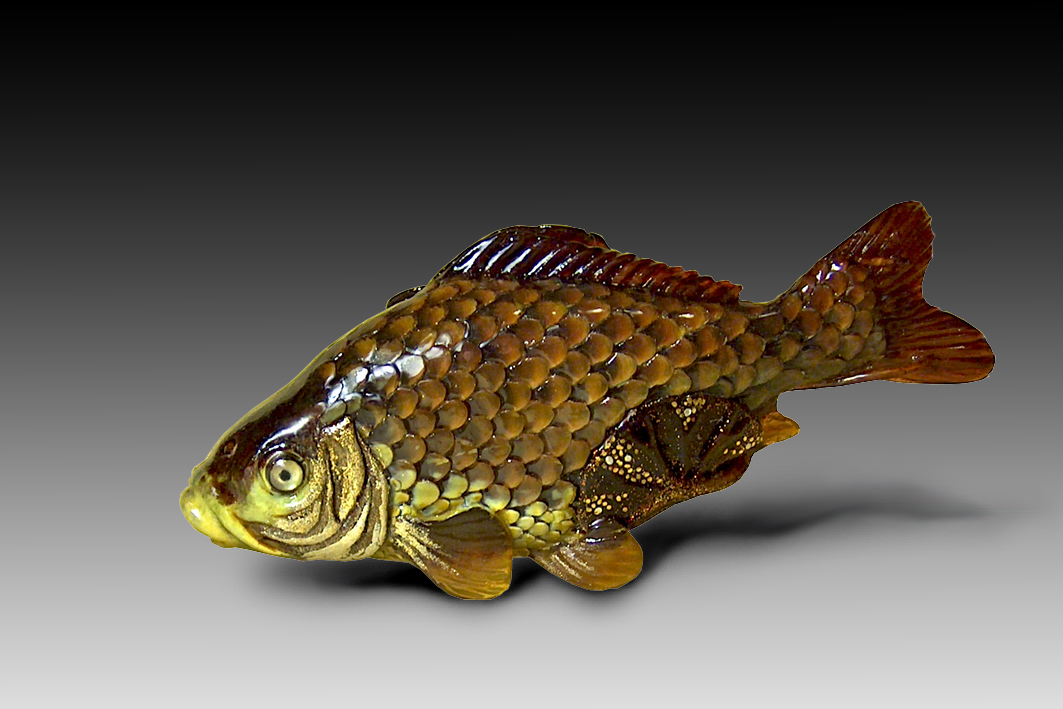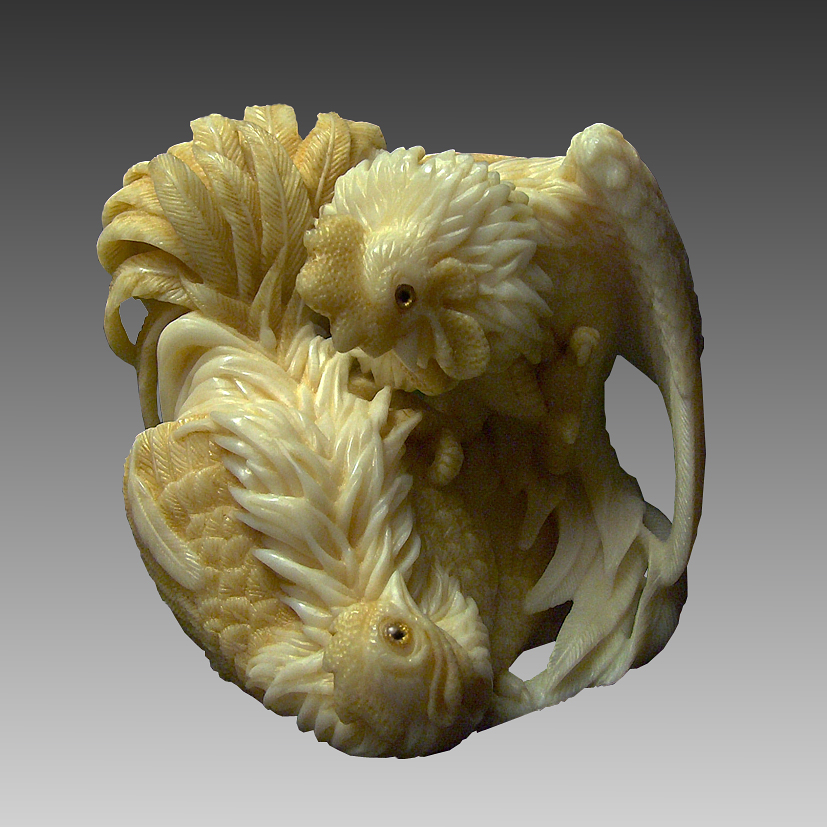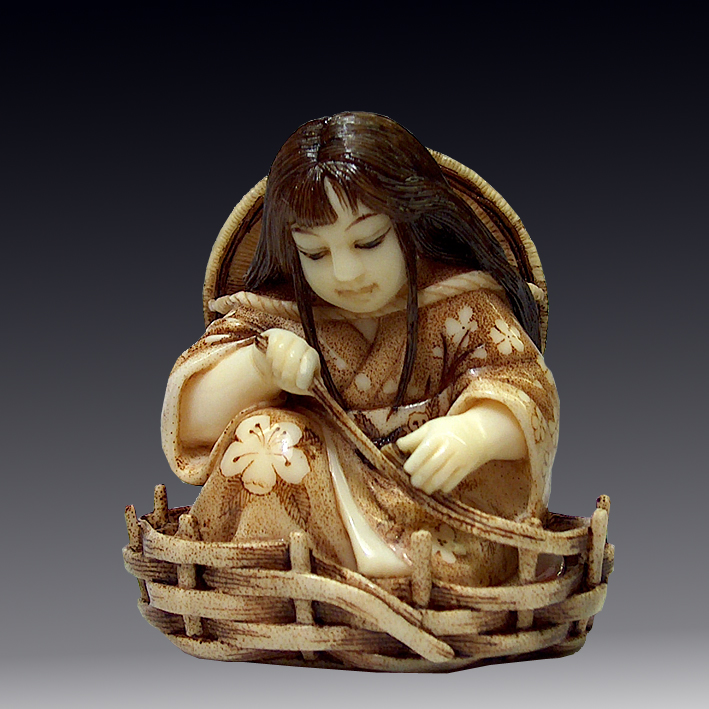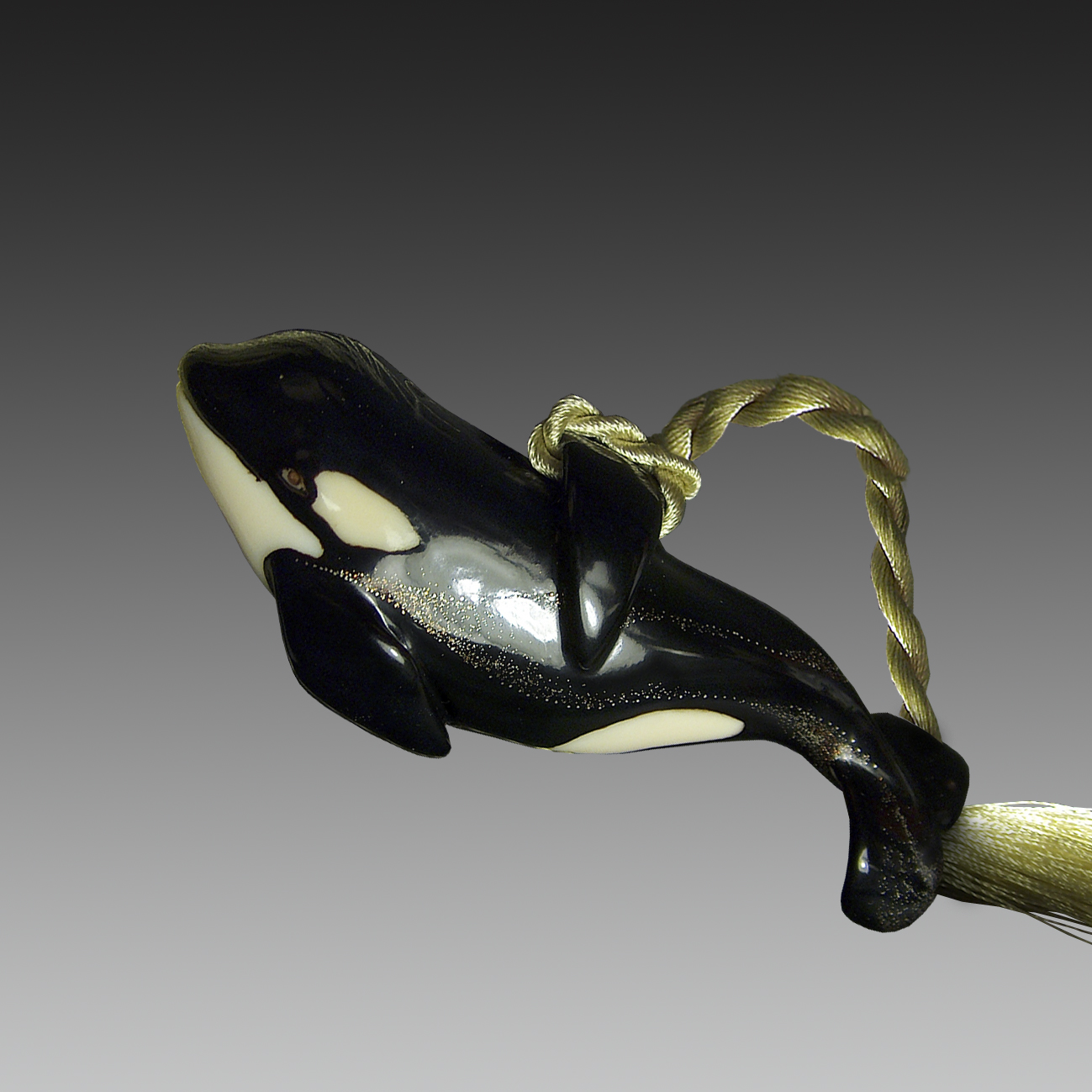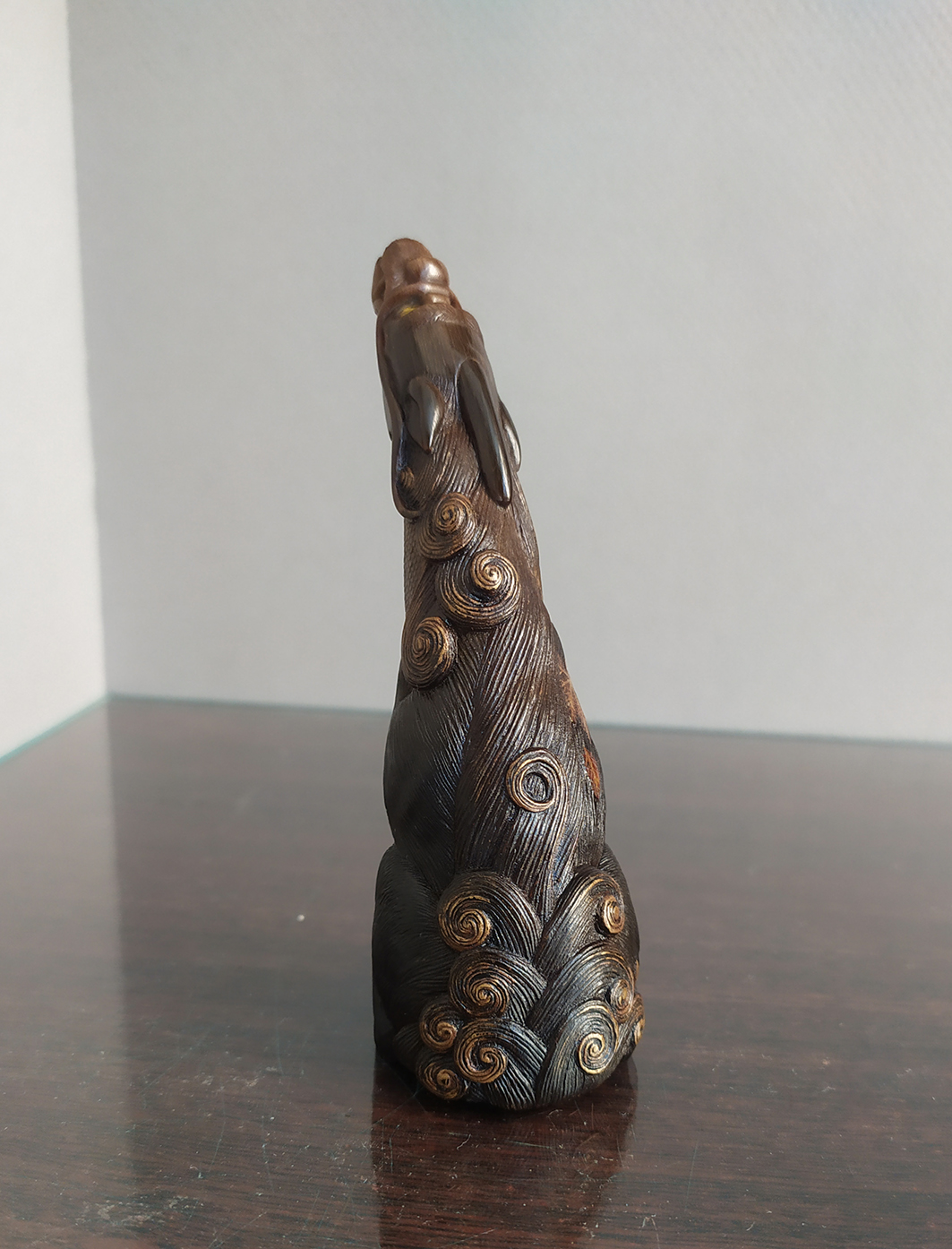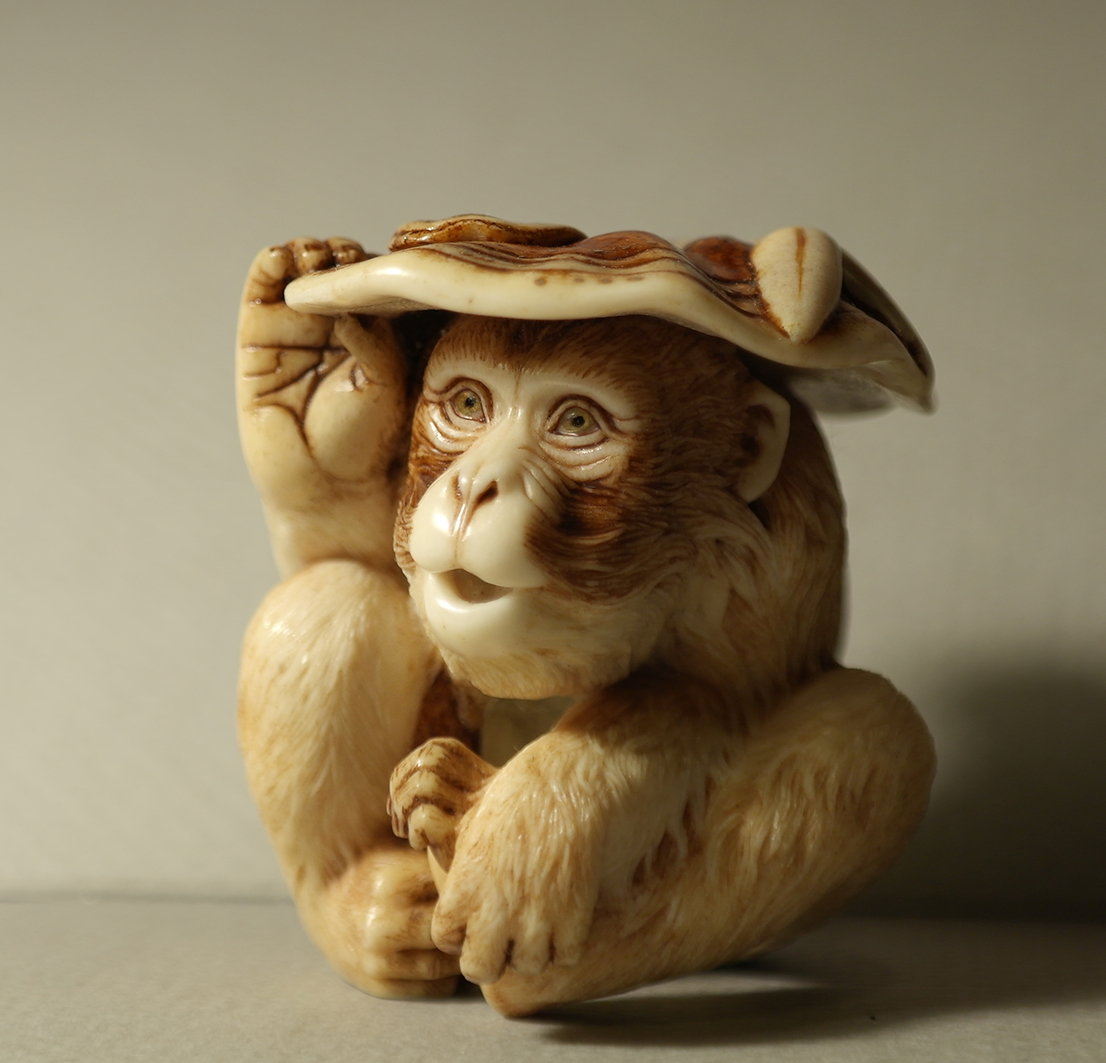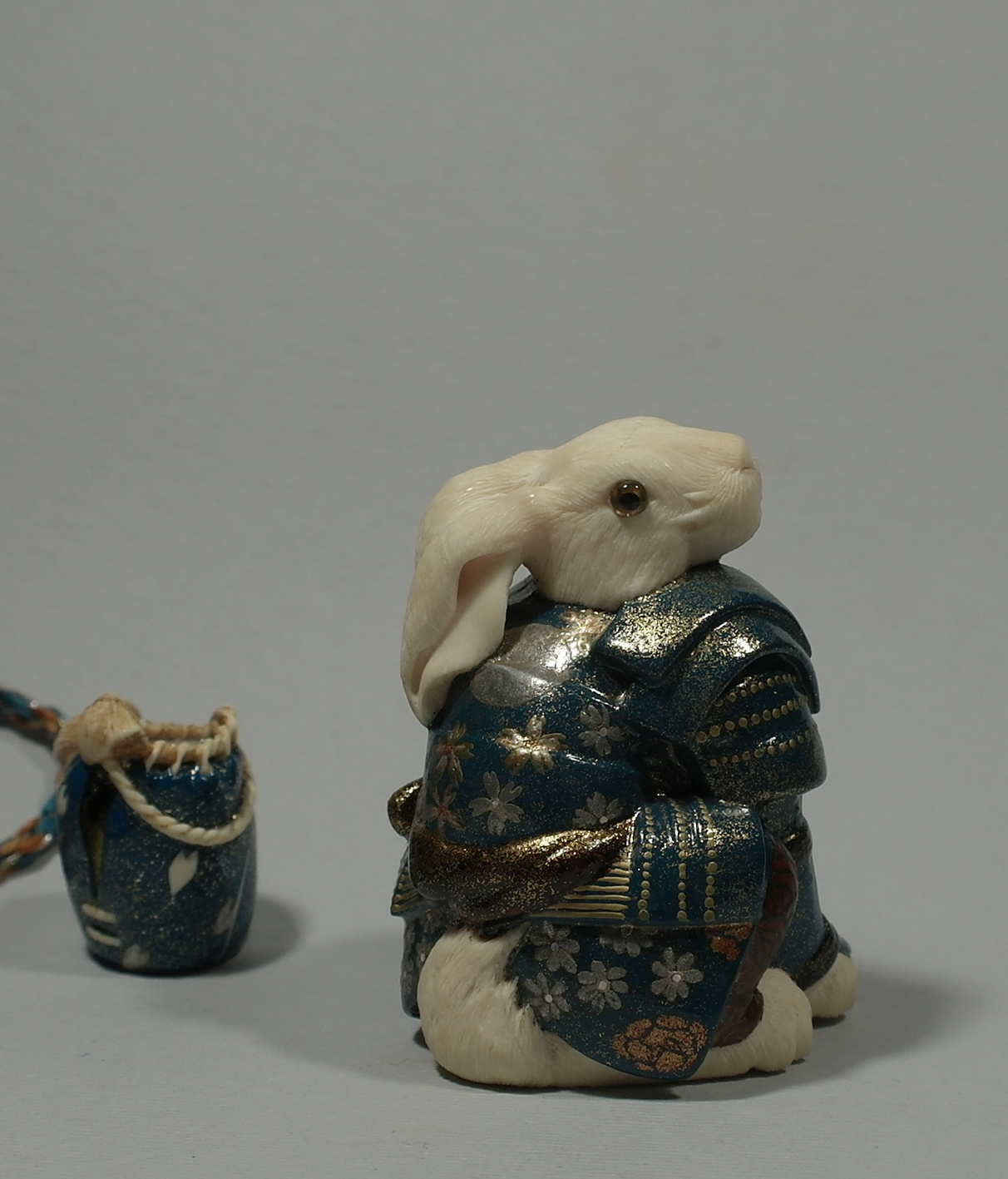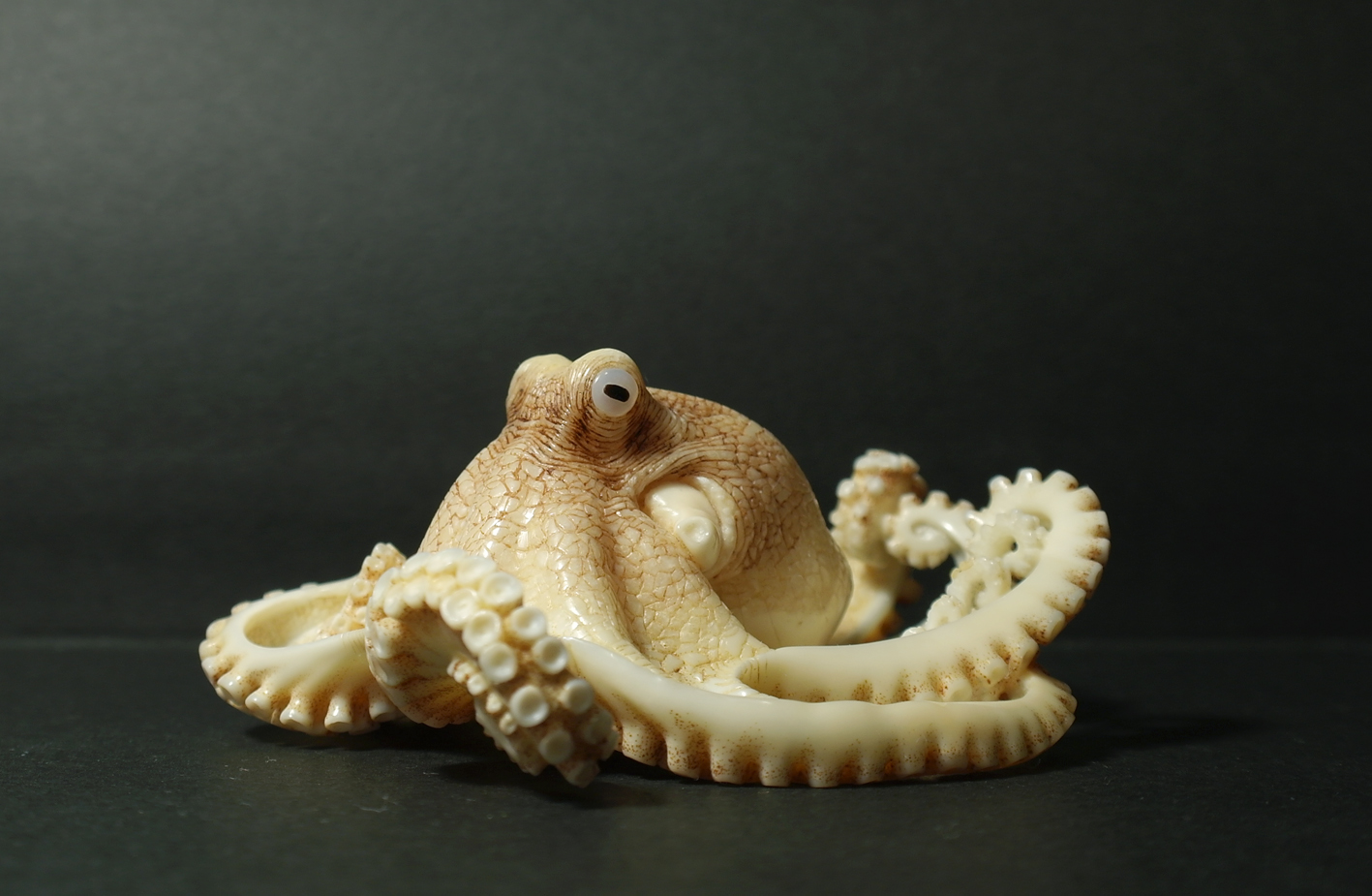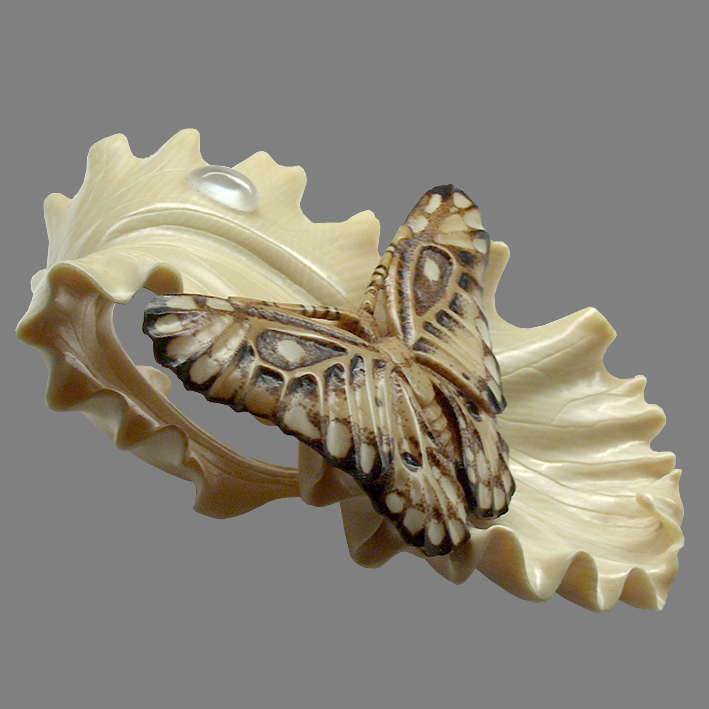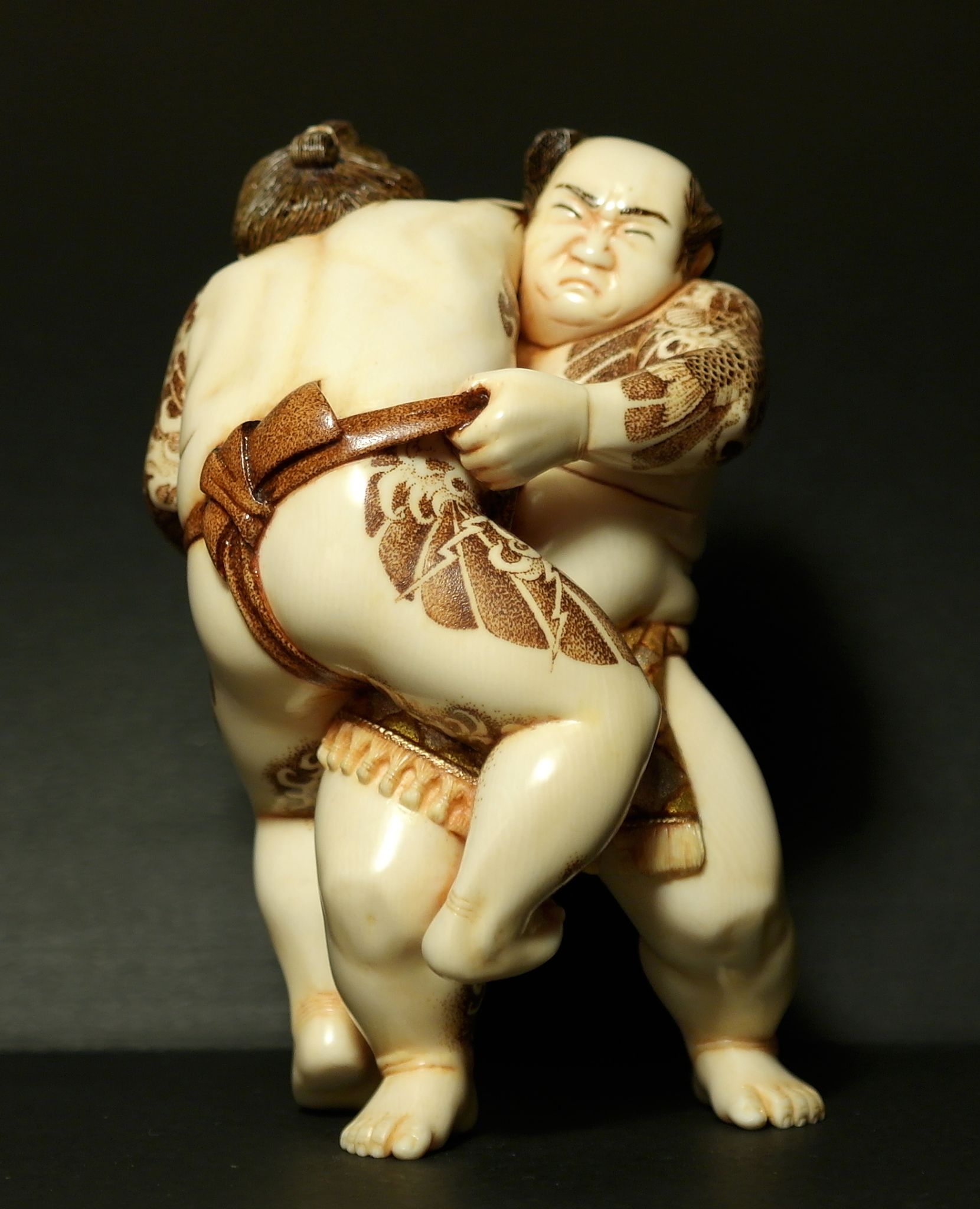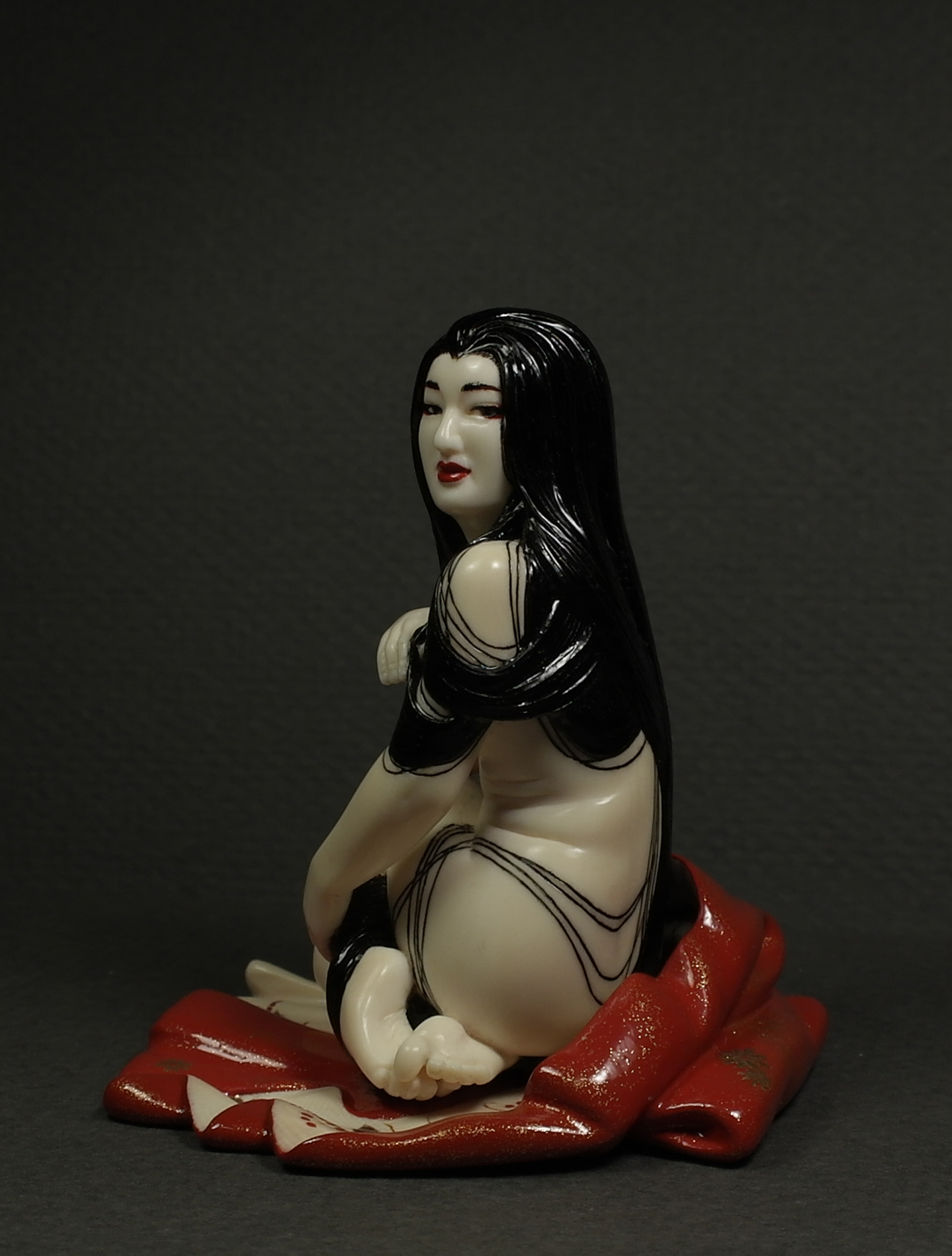KATABORI NETSUKE
BLOSSOMING CHERRY BRANCH
11 images
This Branch was carved from the African wild boar tusk, 12 cm, stained with Walnut ink, the Japanese characters were done with burning needle! :) The haiku can be translated so: Samazama no... Myriads of things past Koto omoidasu... Are brought to my mind - Sakura kana... These cherry blossoms! or so: How many, many things They bring to mind-- Cherry blossoms! Tatiana Nikolova and her friend, Tomoko Watanabe (the teacher of Japanese language and Literature) helped me a lot with the final design and searching this Haiku, with Japanese language and the grammar rules! I thank them both very much! UK, private collection.
![BLOSSOMING CHERRY BRANCH]()
CARP AMONG LOTUS LEAVES
10 images
Netsuke “Carp among lotus leaves” has been carved from pressed buffalo horn, its length is 6.8 cm, bleached, scaled, lotus leaves were lacquered with Nashiji Urushi (Togidashi with gold and silver hiramefun), 2010. Russia, private collection.
![CARP AMONG LOTUS LEAVES]()
FIGHTING BANTAMS
9 images
I was inspired very much with the design by Hokusai, this Katabori netsuke “Two Fighting Bantams” was carved from ivory, stained with Yashabushi, amber/gold inlaid eyes. Its height is 4.5 cm. Russia, private collection.
![FIGHTING BANTAMS]()
HARU-KO
6 images
Haru-ko was carved from walrus tusk. The size is 4.8 cm. The hair and make-up were done with Rose-Urushi lacquer. The ornament on the kimono and the basket were done with burning needle and walnut ink. Three petals were carved from pink coral. 2008. Australia, private collection.
![HARU-KO]()
KAPPA
18 images
Kappa (Japanese: 河童: "river child") is a Japanese species of mermen. Kappa is a child drowned by an oversight of adults, a child doomed to stay in the dusk of lakes, without love, care, a child offended by everyone and everything, therefore in Japanese mythology all Kappa are very evil and harmful creatures, if Kappa is given the opportunity drag someone to the bottom, it will be so. Kappa has a recess on his head with liquid, if Kappa bends down, the life-giving water will pour out and Kappa will lose his strength - this is the only way to defeat Kappa - bow to him, then Kappa will bow back, Kappa is very polite. I had already cut out the plot with Kappa on my Ryusa netsuke , and this time I wanted to create a Kappa with a ghost on the shell - an interesting idea in my opinion, I have never seen this idea anywhere. Kappa tries to see what is on his shell, and the ghost in horror has grown into the shell, now they are friends forever! The Kappa is carved from a piece of fossil mammoth tusk, tinted by Yashabushi and inked from walnuts, burned with a needle and Japanese lacquer - Urushi. Triple inlay Kappa eyes (mother of pearl, black buffalo horn and amber) and double inlay ghost eye (mother of pearl and black buffalo horn). Kappa height 6.3 cm. Ojimi is made in the form of an empty turtle shell, the cord is hand-woven. 2023. Russia, a private collection.
![KAPPA]()
KILLER-WHALE
5 images
This Killer Whale was carved from ivory, covered with black Roiro-Urushi lacquer, silver Hiramefu flakes, Nashiji-Urushi lacquer, amber inlaid eyes, 7 cm length, 2009. Moldova, a private collection.
![KILLER-WHALE]()
KIRIN
12 images
Kirin was carved from a black cow's horn, a fibrous material is difficult to carve in detail. I bleached it in places with hydrogen peroxide, it turned out a very beautiful transition from black to lighter Kirin's face. The whole body of Kirin is covered with hair and scales. The size of every tiny scale is 1 mm. After polishing, the Kirin was covered with Japanese lacquer Kijomi, gold powder Marufun on the curls, ribs protruding slightly on the sides. On its right side, autumn fallen leaves are made using the Maki-e technique using Kanshitsu. The eyes are inlaid three times, mother of pearl, black pupil horn and amber. 11 cm tall. 2020. USA, private collection.
![KIRIN]()
MONKEY
11 images
"Monkey and Reishi" was carved from elk antler, 5.3 cm tall. Amber inlaid eyes, Urushi lacquer, silver Hiramefun, Yashabushi (gardenia seeds), 2015. Switzerland, private collection.
![MONKEY]()
MOON RABBIT
17 images
If You look at the full Moon - Chushu no meigetsu, You can see the silhouette of a rabbit pounding in a mortar either the powder of immortality, or rice - the source of life, but the rabbit turned out to be on the Moon for his self-sacrifice for the Buddha. The rabbit is also known for its good disposition, intelligence and ingenuity, quick legs, and also courage, which is probably why the Silver Gate on the Moon is also guarded by rabbits. My version of the gatekeeper is a white rabbit in armor like a samurai. In other words, this is a story about a Japanese rabbit guarding a bag with a pot, in which either the powder of immortality, or rice. This rabbit is made from a piece of mammoth tusk, the armor is covered with Urushi lacquers, gold and silver powder, the eyes are inlaid, the height of the rabbit is 5.1 cm, ojime is 2.5 cm, hand-woven cord. 2023. Belgium, the private collection.
![MOON RABBIT]()
OCTOPUS
19 images
Octopus has been carved from walrus tusk, its diameter is 7.4 cm. 2016. Switzerland, private collection.
![OCTOPUS]()
PETAL BUTTERFLY
3 images
The petal of Iris with butterfly were carved from mammoth tusk, its size is 5.6 cm, the butterfly was stained with walnut dye, silver nitrate and burning needle. Two dew-drops were carved from two different acryl glass. The beetle was carved from mammoth and dark-brow shell, mammoth was covered silver nitrate. The signature was carved on the reverse side, covered gold leaf 23K and over it was inlaid the dew-drop. January 2007. USA, private collection
![PETAL BUTTERFLY]()
SANKA WITH BAMBOO
9 images
Sanka with bamboo has been carved from mammoth tuisk, 4.8 cm tall, Urushi lacquer, Yashabushi dye, burning needle. 2013. Australia, private collection. The people of the mountains – unidentified inhabitants or nomads who lived by fishing and hunting. They're called Sanka and have never been identified as a different race. Until the family register system was set up after the Meiji Restoration [1868], the Sanka or Sanga were a free people who existed outside the government’s control. They were distributed throughout the whole country from the southern Kyushu region to the northern Tohoku. It is believed that they were pushed north by the peoples who arrived relatively later in history. Refusing to be assimilated, they escaped to the mountains. It is also believed that “they could be part of the Jomon people, J apanese ancestors with a Polynesian linkage.” In other words, their existence can only be explained if we consider them as the part of aboriginal races that resisted assimilation. Sanka had contacts with the new populations so they weren't completely apart from civilization.
SANKA WITH LOTUS LEAVES
9 images
Sanka with lotus leaves has been carved from mammoth tuisk, 4.7 cm tall, Urushi lacquer, Yashabushi dye, burning needle. 2014. Australia, private collection. The people of the mountains – unidentified inhabitants or nomads who lived by fishing and hunting. They're called Sanka and have never been identified as a different race. Until the family register system was set up after the Meiji Restoration [1868], the Sanka or Sanga were a free people who existed outside the government’s control. They were distributed throughout the whole country from the southern Kyushu region to the northern Tohoku. It is believed that they were pushed north by the peoples who arrived relatively later in history. Refusing to be assimilated, they escaped to the mountains. It is also believed that “they could be part of the Jomon people, J apanese ancestors with a Polynesian linkage.” In other words, their existence can only be explained if we consider them as the part of aboriginal races that resisted assimilation. Sanka had contacts with the new populations so they weren't completely apart from civilization.
![SANKA WITH LOTUS LEAVES]()
SUMO
5 images
"Sumo Wrestlers" has been carved from a piece of mammoth tusk, the height of this netsuke is 9.1 cm, tinted with mixed dye (kuchinashi, curcuma and tea), hear - Rose Urushi, mawasi - colored with lacquers and Nashiji flakes (gold and silver), tattoo was done with hot needle. 2013. "Sumo Wrestlers" is a part of the LUB collection!
![SUMO]()
TAYU
25 images
Tayu is Empress Hanamachi, she has 5th rank, the highest degree of skill. In addition to sophisticated communication, the tea ceremony and other subtleties, the Taiu mastered the art of "spring quarters" until the ban on prostitution in Japan in 1956. Netsuke height is 7 cm, inlaid eyes with a black horn, Urushi varnishes: red and black Kuro-nakanuri, gold Nashiji flakes, gold Marufun. December 2021. Russia, private collection.
![TAYU]()
